What Is an FPV Drone? Everything You Need to Know!
Last Updated on
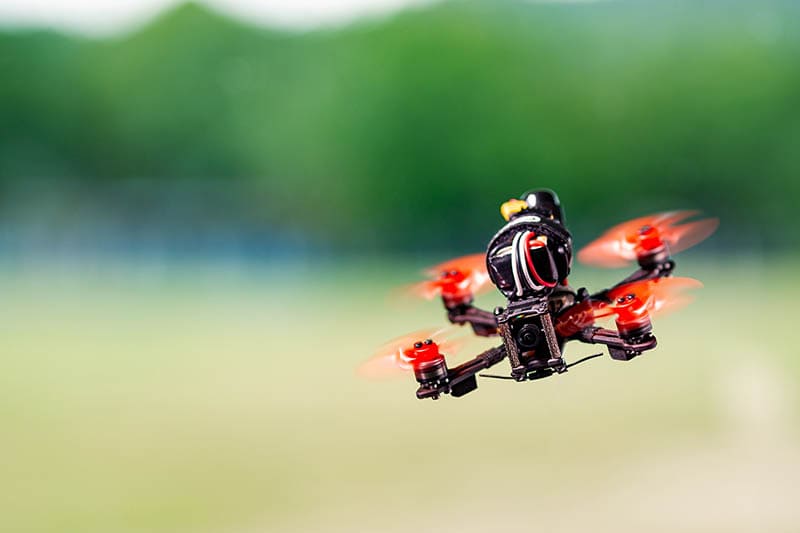
FPV drones allow you to pilot them from the perspective of being onboard the drone itself. Any drone that is flown remotely with a controller, combined with goggles and a heads-up display for the pilot to receive footage from the drone’s onboard camera and transmitter, is considered an FPV drone.
Being able to pilot a drone from this perspective, instead of a line-of-sight perspective (from your position on the ground), does not only make the experience more immersive and exciting, it also helps with navigating around trees and other obstacles—opening the possibility for a wide range of applications, such as search and rescue missions, racing, and agricultural mapping.
In this article, we’ll talk you through everything you need to know about FPV drones, including how they work, their applications, and their benefits.

What is an FPV Drone?
FPV is short for First Person View, and it refers to the method in which the drone is operated, rather than the aircraft itself. With a traditional drone, the pilot watches the drone from their position on the ground, whereas a first-person view gives the perspective of the drone via an onboard camera.
The onboard camera transmits live footage from the drone’s perspective to a receiver on the ground. The footage is then displayed in real-time, either on a screen, or FPV goggles. Flying an FPV drone with specialist FPV goggles can feel a lot like playing a video game. But, in this case, crashing can be pretty costly!
Technically, there is little difference between an FPV drone and a traditional drone. An FPV drone could be flown traditionally, without the use of a first-person view screen. Conversely, a traditional drone that’s fitted with an onboard camera capable of streaming live footage could be used as an FPV drone.

How Does it Work?
FPV drones make use of three main components to work: a radio transmitter, a flight camera, and a screen.
Radio Transmitter and Receiver
Most drones come with a radio transmitter, or remote controller, which transmits the pilot’s control signals to the aircraft and maneuvers it. High-end transmitters also receive and display real-time data from the aircraft, for example, the drone’s battery status, altitude, and more.
Flight Camera
There is a wide range of FPV flight cameras out there to suit different needs and budgets. An FPV camera will capture footage from the drone and transmit it back to a screen of some sort for the pilot on the ground. For this reason, it’s important to choose a camera that has low latency. Some cameras include a microphone, while others are designed to perform well in low light. A good FPV camera will be small and lightweight, and will have the features required for the application.
Screen
The drone’s onboard camera will transmit video to a screen for the pilot. This screen can be a smartphone, monitor, tablet, or FPV goggles. Another popular option is to use a VR headset, which makes use of your smartphone, but excludes any external light from obstructing your view. Providing both the camera and the transmitter have low latency, the pilot can react to obstacles quickly.
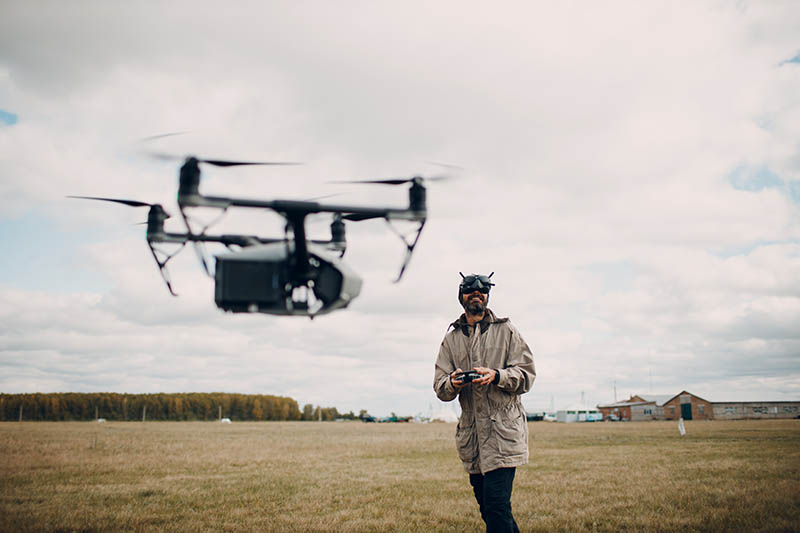
What are the Different Applications of FPV Drones?
Agricultural Applications
FPV drones are used for a variety of purposes in agriculture. They can be used for surveillance, to catch intruders, and for general monitoring to help keep track of livestock’s whereabouts and potential injuries.
Special night-vision FPV drones can be deployed very quickly if unusual activity is spotted in the dark, saving time and human effort for what could potentially be nothing, or arriving faster than otherwise possible if action is needed.
Racing and Freestyle
FPV drone racing is increasingly popular. Being able to race specialist drones whilst immersing yourself entirely using goggles can feel a lot like competing in a video game, but the stakes are higher. FPV races occur in many settings, including forests, warehouses, and fields. Video recorders are often used so the footage can be uploaded to social media afterward.
Freestyle consists of performing impressive maneuvers like flips, tumbles, and air acrobatics. The sport becomes even more impressive when several drones synchronize and perform choreographed maneuvers.
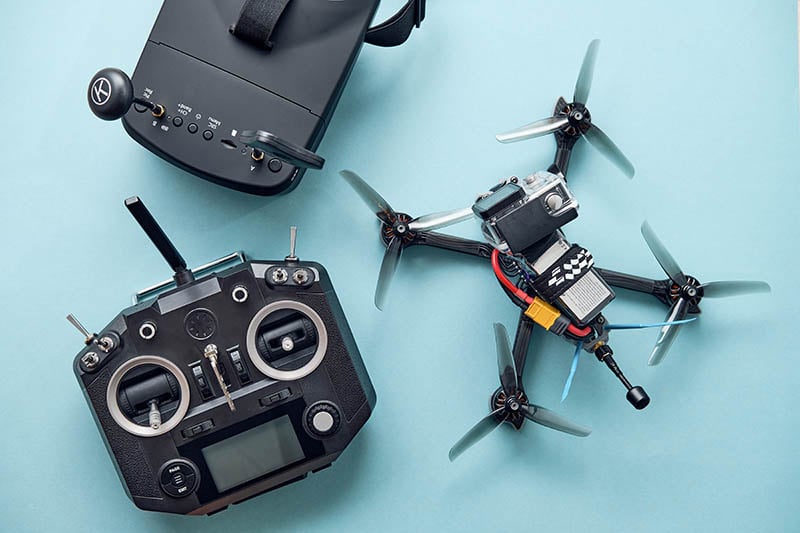
Search and Rescue
The portability of drones makes them perfect for search and rescue missions. Teams can use drones to map large areas without putting the lives of searchers at risk. They’re used to assess situations so that teams can prepare and execute missions accordingly, in much the same way helicopters are used, at a fraction of the cost. FPV drones can even be used to drop vital food and first-aid supplies before the team reaches the survivor, and even communicate with them using the drone’s onboard microphone and speaker.
Filming & Streaming Live Events
FPV drones can be flown over crowds at events to capture and stream footage onto large screens. This can be particularly useful for concerts and parades. They can also be used by journalists to capture footage at marches and protests without the need to put a camera crew at risk of danger.
FPV drones are exceptional for shooting fast action film scenes and sporting events too.
Mapping
FPV drones are perfect for surveying difficult-to-reach places, such as mountain ranges and coastlines. The pilot can fly the drone over areas that need extra attention and, using specialist onboard cameras and tools, the drone will provide accurate new data. This data, combined with imagery, can then be combined to create 3D maps.
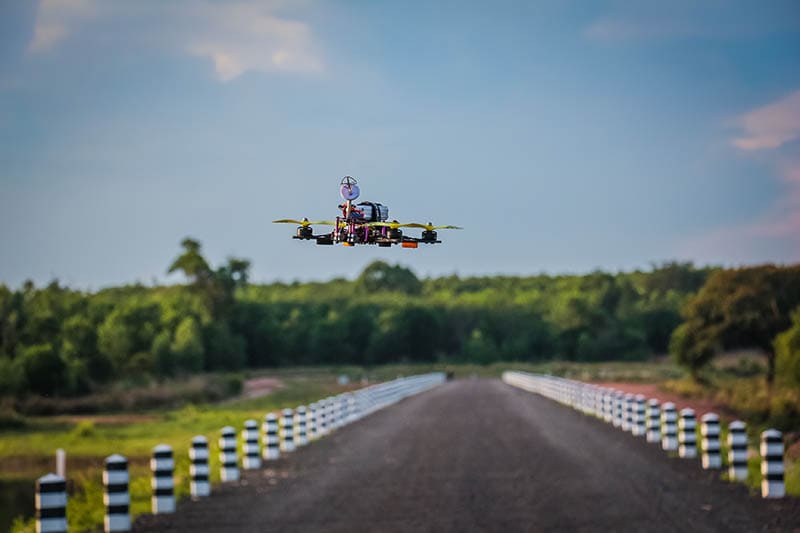
Advantages of FPV Drones
Aside from providing the pilot with the exhilarating sensation of flying in real-time while capturing breathtaking views, the advantages of flying FPV drones are many. Obstacles such as trees are much easier to spot in first-person view, making navigation a whole lot easier for pilots. Aerial photography and videography are much easier, and more accurately done with FPV, as the photographer or videographer will be able to frame the shots exactly as they want.
Disadvantages of FPV Drones
Getting into FPV drones can be a costly hobby. For a start, it takes time to master how to fly FPV drones and, with each crash, there come expensive repairs and possibly even replacements.
Aside from monetary costs, some people report that the first-person view simulation causes nausea and motion sickness, and would much prefer to fly their aircraft using line-of-sight.
In short, the FPV method of flying drones may not be for everyone. For those thinking of purchasing an FPV drone, we recommend trying out some drone simulators first, and starting with an affordable drone before working your way up.
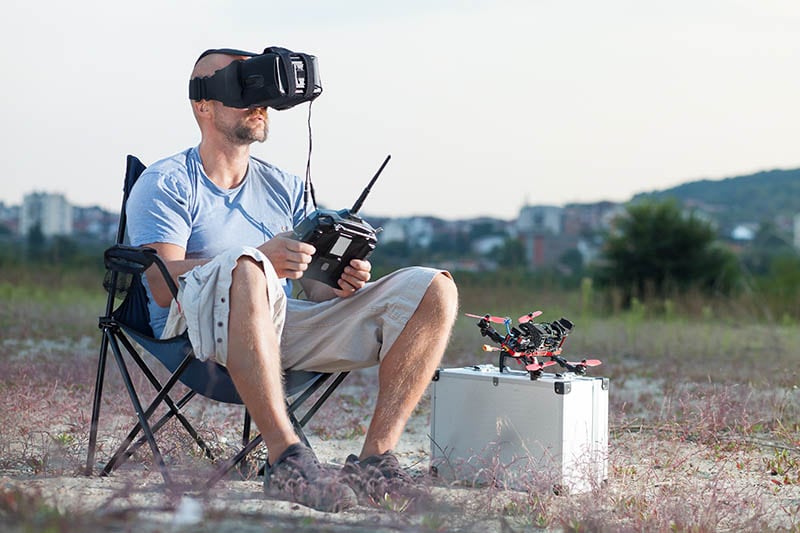
Frequently Asked Questions (FAQs)
Are FPV drones legal?
FPV drones are legal to fly as long as there is a visual observer who can see the drone in their line of sight. Furthermore, some drones need to be registered, so we recommend that you always check the FAA rules before setting out.
Can you fly an FPV drone without goggles?
Yes! In fact, if you are new to flying drones, it’s probably best to practice with your drone in your line of sight before donning a pair of goggles. Furthermore, many FPV drones can connect to your smartphone, monitor, or tablet, omitting the need for FPV goggles.
Is it hard to fly an FPV drone?
Like any hobby, there is a learning curve when it comes to operating a drone. Luckily, the internet is filled with guides and videos on how to fly your FPV drone. Simulators are also a great way to practice flying before you’ve even purchased your first drone!

Conclusion
FPV, or first-person drones, can make you feel as though you’ve got a front seat on your drone. The experience can be exhilarating and just plain fun, but recreation is not the only advantage of FPV drones. They’re being used for increasingly complex tasks throughout the world, from search and rescue, and agriculture, all the way through to construction.
Featured Image Credit: Kietisak Yaemklebbua, Shutterstock
About the Author Cheryl Regan
Cheryl is a freelance content and copywriter from the United Kingdom. Her interests include hiking and amateur astronomy but focuses her writing on gardening and photography. If she isn't writing she can be found curled up with a coffee and her pet cat.
Related Articles:
What Is the Best Binocular Magnification for Hunting? Optical Features Explained
How to Clean a Refractor Telescope: Step-by-Step Guide
How to Clean a Telescope Eyepiece: Step-by-Step Guide
How to Clean a Rifle Scope: 8 Expert Tips
Monocular vs Telescope: Differences Explained (With Pictures)
What Is a Monocular Used For? 8 Common Functions
How to Clean a Telescope Mirror: 8 Expert Tips
Brightfield vs Phase Contrast Microscopy: The Differences Explained
